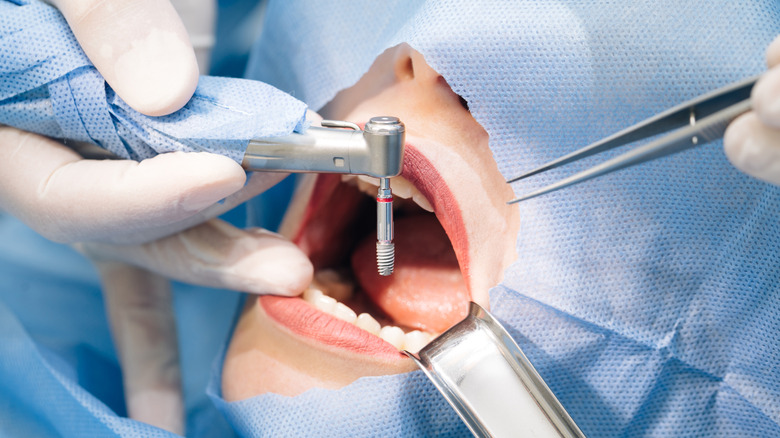The Different Types Of Dental Implants Explained
A dental implant is an artificial structure placed in the jawbone (via Medical News Today). According to a 2018 study published in the Journal of Dental Research, dental implant prevalence is projected to hit 23% by 2026. That's significant growth from 5.7% since 2010, when an increase in prevalence was first noticed. People have dental implant surgery for various reasons (via Medical News Today). Some want to improve their chewing ability or restore their facial appearance. Others have it to replace a missing tooth.
If you're considering this surgery, a consultation with your dentist is the first step, per Mayo Clinic. The surgery involves several procedures and the bone healing process might take many months. You can opt for single tooth or multiple teeth implants, however, various other dental implant options exist, and your dental surgeon will help you choose the most suitable one, according to WebMD. Nevertheless, it helps to understand how each one works before making a befitting choice.
Types of dental implants
There are two basic types of dental implants: endosteal and subperiosteal (via WebMD). Your surgeon might recommend an endosteal dental implant procedure if your dentures or bridges appear intact. The procedure involves inserting a tiny screw-like material into your jawbone to support one tooth or a set of prosthetic teeth. On the other hand, the subperiosteal implant procedure is performed on or above the jawbone. It involves placing a metal post under your gum to hold it in place. The subperiosteal implant procedure might be more suitable if you can't wear regular dentures or have a naturally weak jawbone.
Keep in mind, your dentist might suggest different treatment options alongside the surgery, depending on the health of your jawbone, as per the American Academy of Implant Dentistry (AAID). For example, bone augmentation works best for weak natural jawbones. This procedure restores or regenerates the jaw bone, so it can hold whatever implant material you choose. There's also the sinus lift procedure, where a bone is added below the sinus to make up the deteriorated portion of the natural bone caused by missing upper back teeth, per WebMD. If your jaw is too narrow for dental implants, your surgeon could recommend a ridge expansion. In this case, they'll create a ridge along the top part of your jaw to widen it and bone graft material will then be added.
Dental implant variations and features
Thanks to evolving dental health technology, many dental implants now come with state-of-the-art and highly advanced features. One example is the immediate dental implant, which is gaining popularity as a viable teeth replacement solution, especially for people who have lost their anterior teeth, as noted in a 2015 study published in the National Journal of Maxillofacial Surgery. This implant treatment was developed to shorten the tooth replacement procedure, which could take up to 12 months to complete using the conventional procedure. Apart from its effectiveness, the immediate implant procedure reduces contamination of the extraction socket and the healing time of the soft tissues.
Mini dental implants are also very advanced. According to Healthline, they're less invasive and afford you a faster recovery. The procedure uses a one-piece screw smaller than 3 millimeters in diameter, unlike traditional dental implant screws, which are made of two pieces and are wider. This makes this implant option more minimalistic and guarantees faster results. It also fits into smaller areas of your mouth and isn't painful to place and repair.
How a dental implant surgery is performed
Dental implants follow extensive procedures performed by oral or maxillofacial surgeons, as per the Dental Health Society. The process often starts with the administration of an anesthetic before the implant is screwed into the jawbone. Keep in mind, you might need about 10 to 12 weeks for the gums to heal. Only when the healing process is complete will the doctor continue fitting the crown and ending the process. Nevertheless, your surgeon might spread the procedure spanning various steps starting with an evaluation of the jawbone, gums, and teeth, to ensure your gums are free from periodontal disease and determine how healthy your jawbone is, as explained by Healthline. If your jawbone is too thin or soft, they might recommend a bone graft before starting.
After the evaluation, your surgery will be scheduled and the procedure may vary based on your chosen implant option. For instance, an endosteal implant requires drilling deep into the bone to insert the implant post, while a subperiosteal implant requires no drilling as the implant is placed on or above the bone. The next phase after placing the implant is called osseointegration, which keeps the implant firmly in place. With the implant fixed and your gums and jawbones completely healed, your dentist can perform the last step of placing the tooth. You might not experience any complications after completion, but it's vital to communicate any discomfort to your dentist.
Benefits of dental implants
Implants offer a look and feel as close to natural teeth as possible, notes the University of Illinois Chicago (UIC). They help restore your bite, your smile, and your confidence. Furthermore, implants have been optimized for long service life, per UIC. They can also help improve chewing power since implants become anchored in your jaw bone after surgery, just like your natural teeth. Getting your teeth back with implants is better than leaving your jawbone empty because the longer it stays that way, the more likely it is for you to experience bone resorption.
Implants also come with the added benefit of tooth protection. Compared to conventional fixed dentures, dental implants offer decreased risks and tissue problems, per this 2022 study published in StatPearls. Apart from preserving natural tooth tissues, dental implants can also help restore your jawbone structure, helping you improve facial and bone features, according to UIC.
Risks associated with dental implant surgery
Like with most procedures, various risks are associated with dental implants, according to the Food and Drug Administration (FDA). These risks are present during and after the surgery. For example, you may feel damage to the surrounding natural teeth and tissues during the surgery and you may experience a fracture. On the other hand, after-surgery risks include a sensation of loosening or twisting of the tooth, which is caused by a loose screw. In some cases, the implant body might also become loose, caused by a local infection in bone and gums or by a systemic infection —which is more common in people with diabetes.
Keep in mind, cleaning the gums around the implant after surgery might pose some difficulty, leading to poor oral hygiene. Therefore, you must inform your doctor if you experience any of these risks during or after the surgery to ensure the healthy upkeep of your tooth and jawbone.






